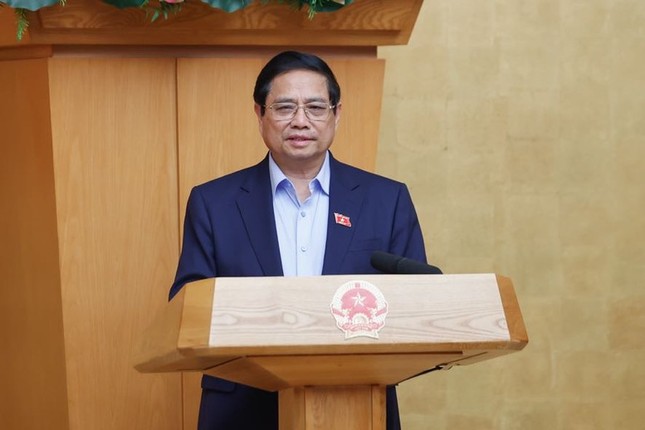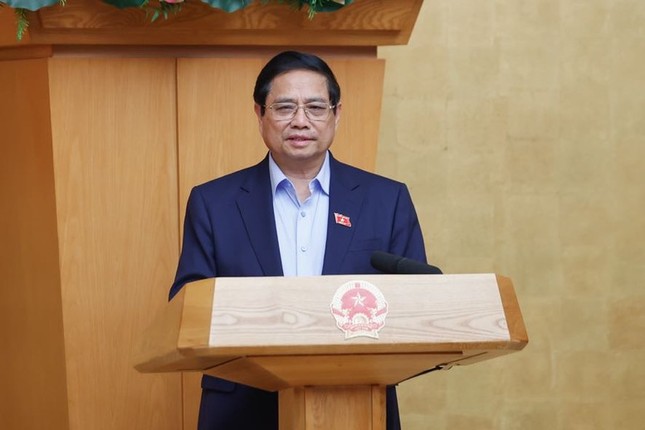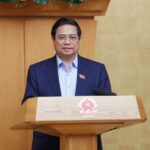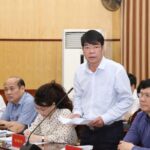At the meeting, the Government discussed the Report on the implementation of the task of rearranging administrative units at all levels and the two-level local government organization, as well as the contents of the dossiers on the proposals for the rearrangement and merger of provinces and cities and the rearrangement of communal-level administrative units to be submitted to the Government. The meeting also covered the building and perfecting of institutions related to the two-level local government organization, the implementation of decentralization and devolution of power between the central and local levels.
Following the meeting, agencies will promptly finalize the dossiers and necessary procedures for submission to the National Assembly Standing Committee and the National Assembly for consideration and decision to carry out.

Prime Minister Pham Minh Chinh speaks at the meeting. Photo: VGP
Earlier, the 11th Plenum of the Party Central Committee (13th tenure) passed a resolution on the merger of administrative units at the provincial level, the non-organization of the district level, and the merger of communal-level units, as well as the building of a two-level local government organization model.
This is a matter of great significance and historical importance, involving not just the rearrangement of organizations, apparatus, and personnel but also the enhancement of authority decentralization, resource allocation, and the creation of new development space, particularly in building a government that is closer and more responsive to the people, shifting from a passive to a proactive stance in serving the people and businesses. The implementation process must ensure the smooth operation of agencies and the daily life of the people and businesses without any disruptions.
In implementation of Resolution No. 60-NQ/TW dated April 12, 2025, of the 11th Plenum of the Party Central Committee and Plan No. 47-KH/BCD dated April 14, 2025, of the Central Steering Committee on the summing up of Resolution No. 18-NQ/TW, the Government has established a Steering Committee for the rearrangement of administrative units at all levels and the building of a two-level local government organization.
With the spirit of “running while arranging the queue,” immediately after the national conference to propagate and implement the resolution of the 11th Plenum of the Party Central Committee, the Government’s Steering Committee has focused on leading and directing the implementation of a number of key tasks. These include issuing guidance documents and urging localities to complete procedures for building and submitting dossiers on the proposals for the rearrangement of administrative units at the provincial and communal levels to the Government.
Over the past time, localities have urgently and seriously implemented the directives of the Central Committee, the Politburo, and the Party Central Committee’s resolution, organizing the collection of people’s opinions and preparing for personnel work in the process of rearranging and organizing administrative units at all levels and building a two-level local government organization.
Recently, at a meeting of the Politburo, the Secretariat, and the Party Central Committee’s Organization Commission, it was reported that based on the synthesis of the proposals of localities, the number of communal-level administrative units is expected to decrease from 10,035 to over 3,320 units (equivalent to 66.91%) after the rearrangement. The locality with the highest reduction rate is 76.05%, while the locality with the lowest reduction rate is 60%.
Regarding local Party organizations, it is expected that there will be a reduction of 29 provincial Party committees (from 63 to 34 provincial Party committees); and over 260 agencies and units under the provincial-level Party committees will no longer be operational. The activities of 694 district-level Party committees and over 4,160 agencies and units under the district-level Party committees will also be terminated. Meanwhile, more than 3,320 communal-level Party committees (2,595 communes, 713 wards, and special districts) will be newly established, along with a maximum of 10,660 agencies and units under the communal-level Party committees.
In terms of the number of officials and public employees at the provincial and communal levels (including those in Party, mass, and governmental organizations), it is expected that after the rearrangement, the provincial level will have a reduction of more than 18,440 officials and public employees compared to the number assigned by the competent authority in 2022. The communal level (communes, wards, and special districts) will have a reduction of more than 110,780 officials and public employees compared to the total number assigned to the district and communal levels in 2022 due to the rearrangement of job positions, streamlining of personnel, and retirement as prescribed. The activities of about 120,500 non-professional staff at the communal level nationwide will also be terminated.
“Unlimited Innovation”: Unlocking Private Sector Growth
The government has unveiled a series of strategic resolutions, known as the “Fab Four,” which are set to revolutionize Vietnam’s future. These include Resolution 57-NQ/TW, which focuses on breakthrough development in science, technology, innovation, and digital transformation; Resolution 59-NQ/TW on international integration; Resolution 66-NQ/TW, which aims to reform law-making and enforcement; and Resolution 68-NQ/TW, dedicated to fostering private economic growth. These resolutions are designed to work in harmony, creating a vibrant and innovative Vietnam, open to global opportunities, with a robust private sector and a legal system to match.
The Prime Minister Chairs a Cabinet Meeting on Five Key Legislative Projects for Submission to the National Assembly
On the morning of April 18, Prime Minister Pham Minh Chinh chaired the second Government meeting on law in April 2025. The meeting discussed several important issues in preparation for the National Assembly…
The Art of Provincial Mergers: Streamlining Administrative Boundaries
The government has instructed the Ministry of Home Affairs to take the lead in collaborating with relevant agencies and local authorities to promptly develop a proposal for the continued reorganization and streamlining of administrative units at the provincial, district, and communal levels. This initiative aims to enhance efficiency and effectiveness in governance. The proposal will be submitted to the Party Committee of the Government, ensuring both quality and timely implementation.





















